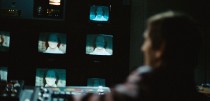Ironically, given Glasgow’s long association with vaudeville – its Panopticon is the oldest surviving music hall in the world – the cabaret scene is the furthest away from the theatrical tradition of all these loose groupings. Perhaps due to the energy of the burlesque revival, which has now evolved into a burlesque establishment, cabaret has remained at one remove from the main spaces and venues: only Rhymes With Purple, organisers of Dr Sketchy’s Glasgow and the sophisticated Art Club Cabaret, have a foot in the theatrical camp.
While there is a far closer affinity between the cabaret acts, the scene itself is sub-divided. The variety strand is represented by Art Club Cabaret, Spangled at The Rio and the afternoon shows at the Panopticon: burlesque may appear at these nights, but it has its own distinct audience and events. Within variety itself, there is a clear split between the vaudeville flavours of the Panopticon, the supper club song and dance of Art Club or the Supper Club at the Tron and the more punk rock stylings of Spangled and the political cabaret hosted by Glasgow legend Tam Dean Burn.
Burlesque often takes the lion’s share of the coverage, mainly because it is both a tightly knit community and has enough internal contradictions for several PhD theses. Nearly every performer will comment that burlesque is primarily about parody, yet striptease dominates the routines: a recent innovation has been go-go dancing, which poses fascinating questions about the feminist defences of the scene. Briefly, the burlesque scene began as a community, with a clear emphasis on reclaiming glamour and celebrating body image. This strong community foundation enabled its revival, but now that it has become financial viable, the political debates that it generated are begging answers.
Cabaret itself is really a format rather than a style: Spangled is half way between a music gig, starring Scunner and The Glasgow Glam Bangers, and an open night of poetry and outré performance. Within this, there are acts that consciously recall vaudeville, and others that have a direct connection to musical theatre. Despite an enthusiasm for the past – the Panopticon is dominated by revival acts – cabaret is elegantly post-modern, fusing contemporary aesthetics with classic skills.
Key Performers
The Creative Martyrs . The break-out act of Edinburgh Free Fringe 2010, The Martyrs made the leap from solid cabaret turn to full on art explosion with an hour long show that took in mime, story-telling, singing and dark humour. Equal parts Weimar, East European and British vaudeville, they have a rare political edge that is incisive and profound.
Rhymes With Purple. Also known as a theatre company, RWP are an axis of variety charm. Rufus and The Not So Impressive Ben are a rare compere double act; Lucille Burn teams with rock pianist Gorman for reinvention of the chanteuse. They are also energetic promoters, supporting high quality production values and a genuine variety aesthetic.
Dolly Tartan. Leader of her Tartan Army, Dolly punts a pair of nights: La Cheetah and The Red Door. The latter is a benefit for the Panopticon, and a key event for the burlesque community. La Cheetah is a mixture of new and established burlesque acts: she also invented the Burlesque X Factor, bringing a competitive drama to the supportive scene.
Charlie Montgomery. Best known for his duets with Leggy Pee, this three foot dynamo charms adults and children alike: he is also one of cabaret’s most well-read critics. His long career on the cruise ships gives him an aura of old school professionalism, despite his louche onstage antics and sharp online quips.














Comments